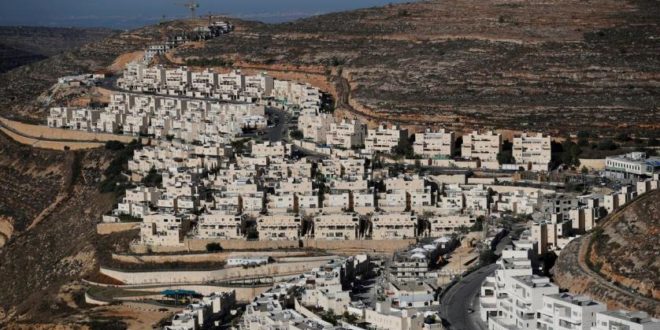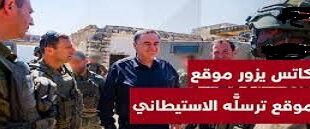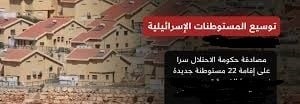By: Madeeha Al-A’raj
The National Bureau for defending land and resisting settlements ( nbprs ) stated in its latest weekly report , that Israeli authorities step up their settlement activities in the occupied West Bank, including Jerusalem, under the outgoing US President Donald Trump’s term in office, as they approved in the first 3 years of his presidency the building of about 7,000 housing units annually, nearly double the average of settlement units built during the administration of previous President Obama that amounted to 3,600 units with the aim of undermining the possibility of reaching a political agreement with the Palestinians. The year 2020 was not the worst political year for the Palestinians, but also the number of Arab countries scrambled towards free normalization with the occupation state. In spite of the political crisis that afflicts the occupying state by dissolving the Knesset and heading to fourth elections within one year, the projects of Judaization and settlement expansion do not stop.
The last week of 2020 was no better than the rest of the previous weeks and months in terms of settlement expansion, continued Judaization and the increasing attacks of settler flocks, as the occupation government insists on exploiting all possible opportunities of the remaining days of the Trump’s administration to move forward with its settlement plans and establish facts on the ground before Jan. 20, 2021, as David Friedman, the US Ambassador to Israel, called for strengthening construction in settlements in the West Bank in response to the killing of an Israeli settlement near Jenin. Friedman considered that the only response is to stay here and expand construction.
At the same time, the Israeli Minister of Settlement, Tzachi Hanegbi, announced the formation of a specialized team to monitor and follow up the Palestinian construction operations in the C-classified areas of the occupied West Bank. Accordingly, the Ministry intends to establish departments for inspecting Palestinian construction in Area C in the West Bank. The Israeli Ministry published the criteria for transferring funds to settlement councils to establish these sections, so that these councils would be able to request the ministry to finance salaries for field inspection trips and to purchase cars, drones, electronic guarding means, and aerial photography. The ministry had allocated 20 million shekels for the investigation of Palestinian construction in Area C. It should be noted that the occupation prohibits Palestinian construction in Area C, which is under its control and inhabited by about 20,000 Palestinians.
In Jerusalem, the Local Committee for Planning and Building in the municipality of Moshe Lyon approved the plan for the settlement ‘Nahal Zimri Park on the lands of Beit Hanina and Hazmah and parts of the lands of Jaba’, north of Jerusalem, near the settlements of Pisgat Zeev and Neve Yaqoub. The Municipal Department of Urban Planning had prepared a policy document of the green organizational structure of the northern settlements in the city. According to the plan, large areas of confiscated Palestinian lands will be allocated to this project, which aims to Judaize Jerusalem in its entirety, and the occupation municipality has published details of the project on its official website and on the notice board, and considered this project one of the most important projects that link the transportation network to Jerusalem with all parts of Israel through the light and the huge trains, it is expected that by the year 2023 all settlers in ‘Gilo’ will be qualified to use the light train.
List of Israeli Assaults over the Last Week Documented by the National Bureau:
Jerusalem:
- Attacking the homes of citizens in the Sheikh Jarrah Neighborhood, closing Street No. 1, and attacking the homes of citizens living in the neighborhood under the protection of the Israeli police.
- A decision to evacuate two homes in the Batn Al-Hawa Neighborhood inside the town of Silwan, in favor of the settler group Ateret Cohneim under the pretext that “the land has been owned by the Yemeni Jews since 1881.”
Ramallah:
- Throwing stones at the cars of citizens passing by the town of Sinjil, north of Ramallah. And attacking the Khan-Laban area near the Eastern Laban village, south of Nablus, to seize it. The khan is considered one of the landmarks built during the Ottoman era in Palestine, and it was subjected to more than one attempted assault and seizure by settlers. Its area in addition to the surrounding lands from the plain of Laban is about 300 donams.
Hebron:
- Excavation and construction in the old central bus station near the entrance to Al-Shuhada Street in the center of Hebron with the aim of constructing a complex that includes all the requirements of the Army Executive Brigade as an integrated force.
- A house, and two stores were demolished in the Khallet Ghazouya area, east of Yatta, south of Hebron. They also demolished a tin-house in the Wadi Ajhaish area near the ‘Susiya Settlement, and confiscated a residential tent in the village of Al-Buwaib, east of Yatta.
- Forcing the Salaymeh family to remove a banner installed by the Independent Commission for Human Rights in cooperation with the Hebron Municipality and the Southern Region Youth League in the city, from the wall of their house located in the Jabal Jawhar area in the old municipality of Hebron under the pretext that the sign includes a weapon that form a provocation to the settlers and the occupation army.
- Attacking shepherds in the Al-Tha`la area, east of Yatta, south of Hebron, preventing them from entering pastures, and attacking their sheep with stones and clubs.
Bethlehem:
- Uprooting Hundreds of olive trees of the village of Al Jab’a, southwest of Bethlehem. The occupation authorities also notified citizens to evacuate their agricultural land in the village of Al Walaja, located in the areas of ‘Jabal Ruwaisat’ ‘Aruq Zunaid’ and ‘Khirbet Abu Shawer’ under the pretext that they are ‘absentees’ property’.
- Dozens of settlers demonstrated on Al-Quds – Hebron St. in the vicinity of the ‘Gush Ezion Settlement’ bypass road for the second week in a row, and raised slogans calling for the departure of the Arabs, closed the main street in front of Palestinian vehicles and threw stones at them.
Nablus:
- Preventing citizens in the towns of Jaloud and Qaryut, south of Nablus, from reclaiming and cultivating their lands. People were suspended from working and fencing them.
- Demolishing two repair vehicle workshops in Al-Lubban Al-Sharqiya, located on the main road connecting the cities of Nablus and Ramallah.
- Attacking citizens’ vehicles in the town of Huwara, south of Nablus, and closed the main street in the town and pointed weapons in the faces of passers-by.
- Attacking citizens’ vehicles with stones near the Tanib Factory, west of Deir Sharaf, west of Nablus, on the road connecting the cities of Nablus and Tulkarm, and others attacked vehicles near the village of Naqura in the north, causing damage to a number of them.
Salfeet:
- Uprooting about 300 olive trees in the village of Haris and leveling areas of 14 donums of land near the Haris, Dirastita and Qarawat Bani Hassan villages, west of Salfit, with the aim of expanding settlement in the area.
- Demolishing a residential room on Wadi Qana road, west of the town of Haris under the pretext that the area is classified as area C.
- Storming the town of Al-Zawiya and took measurements of 2 houses there, and a house in the Marda town, as well as 2 houses in the town of Burqin under the pretext that these houses are not licensed and located in area C, despite being part of the master structural plan of these towns.
Jenin:
- Handing demolition orders of 4 houses in the Ta’nak village, west of Jenin, and a greenhouse under the pretext that the buildings are based on archaeological area and are unlicensed.
- Demolishing of 3 vegetable stands in the town of Barta’a, which is isolated behind the annexation and racial expansion wall, southwest of Jenin, and threatened to demolish an agricultural greenhouse west of Jenin under the pretext that the area is archaeological site.
 المكتب الوطني للدفاع عن الارض ومقاومة الاستيطان منظمة التحرير الفلسطينية
المكتب الوطني للدفاع عن الارض ومقاومة الاستيطان منظمة التحرير الفلسطينية




